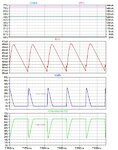Mustafatarhan49
Junior Member level 2
Can you please show me on the output graph how do you see crossover freq 80kHz? I am measuring the output of the error amplifier to see crossover freq and phase margin. Is it wrong?Your small signal compensation looks okay, I'm seeing a crossover frequency of about 80KHz with a phase margin of about 50 degrees. It should be stable (in the small signal sense).
Looking at the transient simulation, it looks like there are many problems with the PWM modulation. Like crutschow pointed out you don't have any ramp signal, which means things simple won't work. Also your switching frequency needs to be at least twice your crossover frequency, in practical terms a factor of five is more reasonable. Also I doubt your gate drive circuit will work effectively at 150KHz, it's probably too slow.
Yes, both of you are right. I actually replaced my pulse with the sawtooth and i will do it in the board as well. I will try to use pwm driver. Can you suggest me any driver?
thanks a lot!
- - - Updated - - -
You're correct about R2 of course. I didn't look carefully at the schematic and thought it went to ground, not the MOSFET gate.
You don't seem to have enough output capacitance to give a reasonable low ripple voltage. I got a reasonably stable output by changing C1 to 20µF, reducing the loop gain by changing R5 to 42kΩ, and rolling off the loop response by changing C4 to 1nF (Those are not optimum values since there is still some low-level oscillation in the inductor current). The output ripple was about 20mVpp with those values.
I used a soft-start time-constant of 0.6ms, which avoids any significant start-up overshoot.
Note that you should have a resistor in series with Q1's collector since there's noting to limit the current through the zener diode D2 when Q1 is ON. Something between 500Ω and 1kΩ should work.
gotchaa! Now it looked much better! Btw, Soft start time mean RC time constant right?


